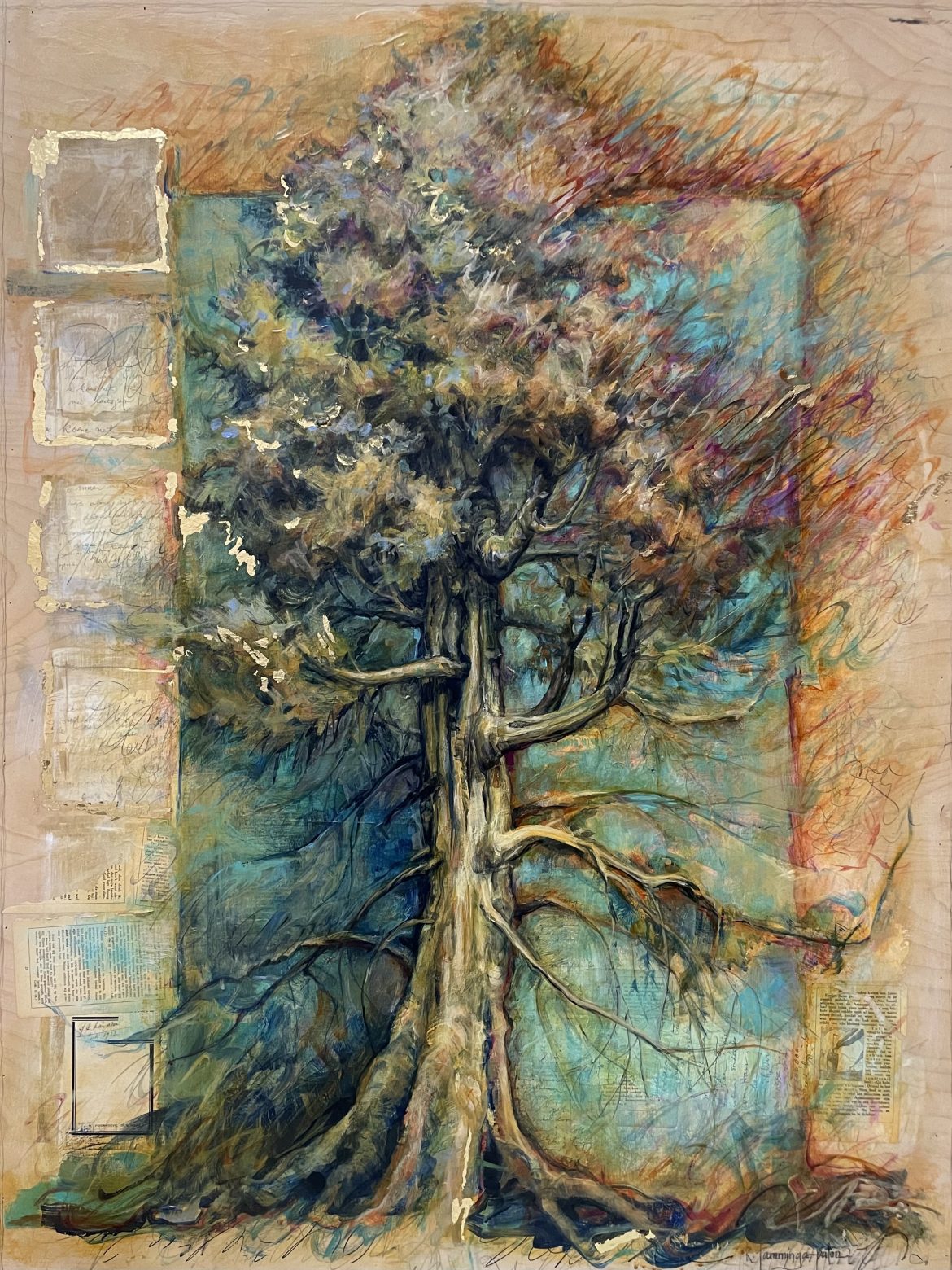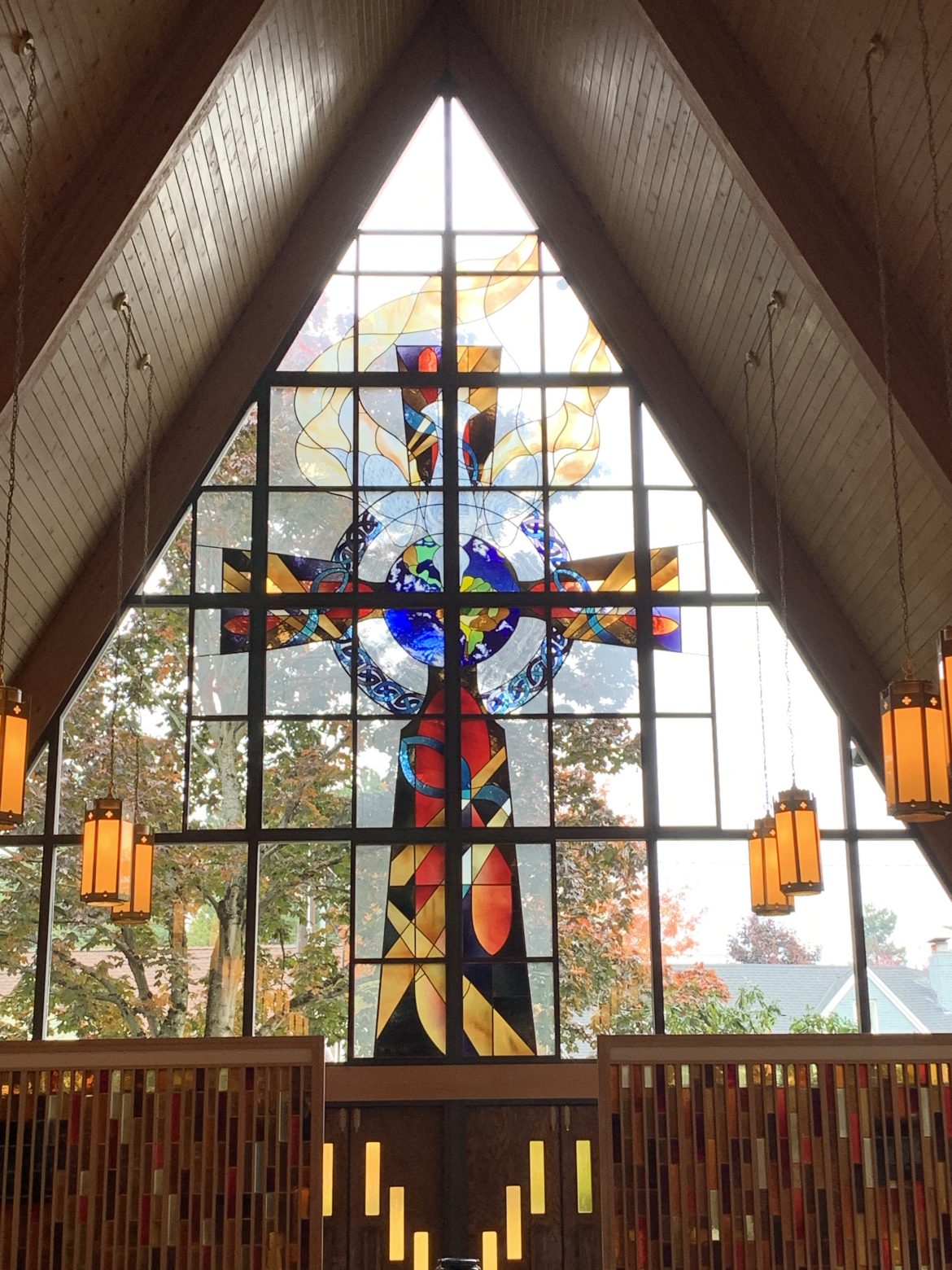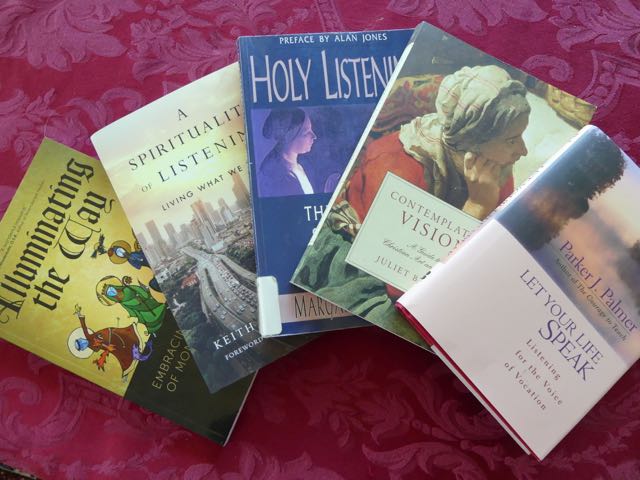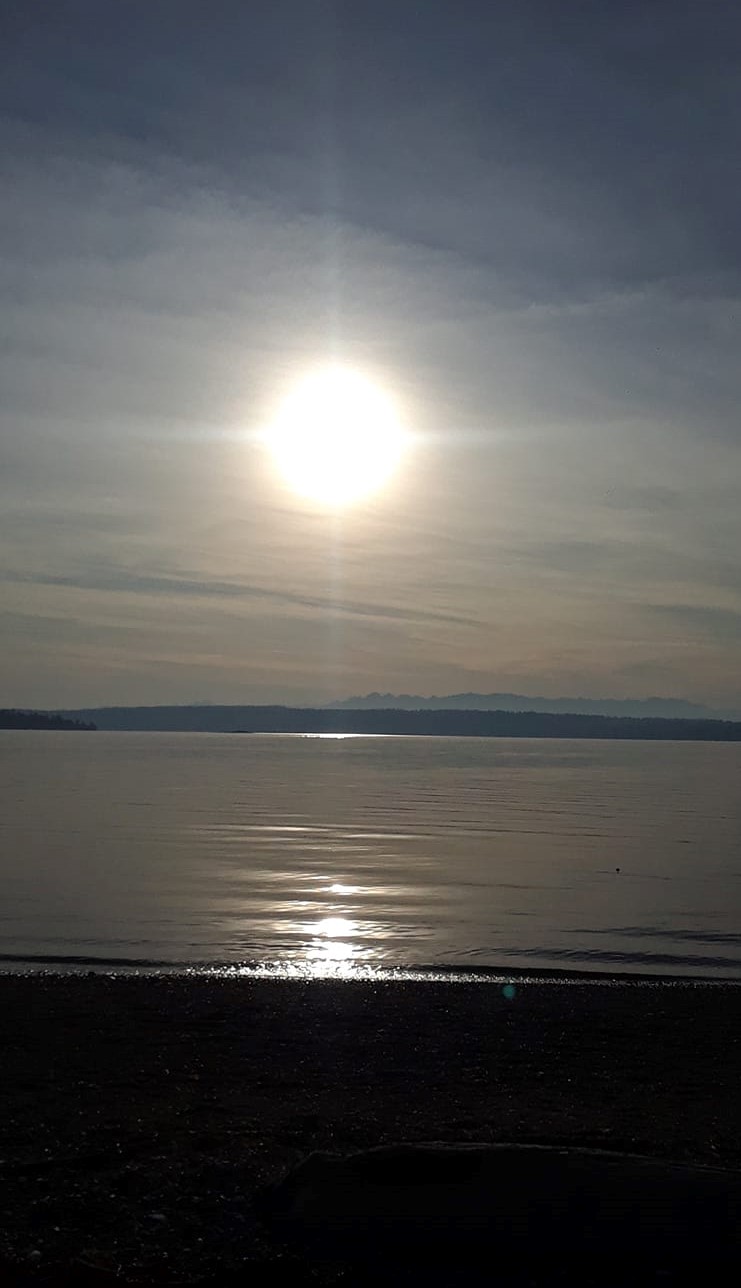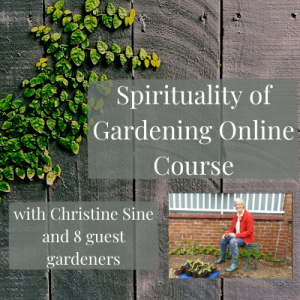Pen and Paint Ponderings with Karen and Karen: Art by Karen Tamminga-Paton with reflection by Karen Wilk.
Before you read the reflection below, we invite you to take a moment to contemplate the artwork. Pause and reflect, and notice your own observations about the work and what thoughts it sparks in you. Then read the poem below.
I Hear With an Accent
I hear with an accent
But not so this noble tree
Call it a default
a challenge
My descent,
Upbringing or past–
You have one too.
Mine has an accent,
Sometimes sweet retreat
But bias
jaded?
Blinded
Embedded
Deadheaded.
Makes me mad,
Makes me sad
Why couldn’t I hear it?
Why did I believe it?
Community prejudice
In gilded frames
Frames too tight for wiggling
For outside the line colouring
For growth and different thinking–
For majesty and mystery linking
to a bigger God
The God who makes little cones into
Douglas Firs
Ancient, regal, divine
Holding many secrets
Including those
beyond our time
Old but ever new
Deep roots
Ever seeking
Ever nurturing, ever reaching
Branches out stretching
To the sky
Soft, fresh needles sprouting
Shading
Nourishing little creatures
Song birds singing
Animals scratching
Wise One without words preaching…
Are we listening, hearing?
Why can’t we be more like this grand tree?
Age-old, strong, evergreen, free
Ever changing, growing to be
More and new
Waving, engraving space for scribbles
In gold
And green, orange, red, blues
What might the future hold
How might our lives enfold
If we could only let go
And hear, learn, share multiple accents–
In startling rainbow hues
Like many branches growing each unique and true
All a gift that life and thriving represents
Beyond our limited thinking
not bounded by our clouded contexts.
If I were to listen to the Tree
and more importantly
To the God who made it to be
Our Teacher
What would I hear and be?
Would Creator’s accent set me free?
Creator’s accent
Glorious, expansive
Radiant, vivid, advansive
Brave, and bold, glance of
Young and old
On the left and on the right,
In the middle and in sight
Inviting me
Curiously,
Into the subtlety
Of frameless holy profundity
To scribble in infinity
To play and learn and dance abundantly,
To be still in Fir Tree’s company–
To change and grow
To know, not know and let go
As I am and will be, aglow
Underneath Creator’s Tree…
Speckled sunlight beams
Underground living water streams
Engraced
Embraced
With space
Beyond frames’ measure
All are free– Ancient new fir tree
Golden growing Godly treasure.
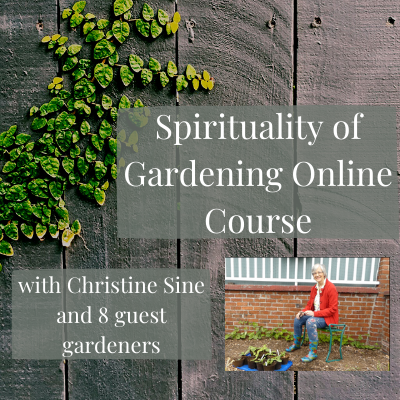
Spirituality of Gardening Online Course
~ Goodfellow
Explore the wonderful ways that God and God’s story are revealed through the rhythms of planting, growing, and harvesting. Spiritual insights, practical advice for organic backyard gardeners, and time for reflection will enrich and deepen faith–sign up for 180 days of access to work at your own pace and get ready for your gardening season.
by Christine Sine
This week holds some very important and fun celebrations from many traditions. As Kate Kennington Steer expressed in her Imbolc post a couple of years ago:
February 1st/2nd/3rd offers up multiple gifts to this season of grey: the Feast Day of St Brigid; Candlemas (the Feast of the Presentation of Jesus Christ, the Feast of the Purification of the Blessed Virgin Mary, and the Feast of the Holy Encounter); the Celtic festival of Imbolc; and lastly, the Saints day of Simeon and Anna. All four are intimately connected.
For those that are unfamiliar with it, Imbolc is a well known pagan Celtic tradition stemming from Neolithic Ireland and Scotland. It celebrates the halfway point between Winter Solstice and Spring Equinox, considered by some to be the beginning of spring However I must confess that here in Seattle, though spring might be in my mind it is certainly not yet in the air. It was this tradition that gave rise to Groundhog Day in the U.S.
Candlemas, also known as the Feast of the Presentation of Jesus Christ, the Feast of the Purification of the Blessed Virgin Mary, or the Feast of the Holy Encounter, commemorates the presentation of Jesus at the Temple, based on the account in Luke 2:22–40. It also marks the conclusion of the Christmas–Epiphany season for some traditions. On Candlemas, many Christians (especially Eastern Orthodox, Roman Catholics, Lutherans, Anglicans and Methodists) also bring their candles to their local church, where they are blessed and then used for the rest of the year. These blessed candles serve as a symbol of Jesus Christ, the Light of the World. I know of some Christians who even bring their light bulbs in to be blessed because they don’t use candles.
Imbolc and Candlemas February 2nd are both celebrations of light and the first spark of spring. I love how Christianity took existing celebrations like this and transformed them into celebrations of faith. Imbolc and Candlemas are interwoven with the celebration of St Brigid’s day which begins on the evening of February 1st and extends to the evening of February 2nd. For Imbolc bonfires were often lit and combined with a feast to St Brigid.
St Brigid is my favourite Celtic saint. She is also known as “Mary of the Gael”, was an abbess and is now patron saint of Ireland. She is founded the first Irish monastery in County Kildare, Ireland. Born in Dundalk in 450 AD, Brigid is accredited with first creating the unique cross which bears her name. This cross is normally hand created from rushes however occasionally straw was also used. Today, as these materials are rarely available people make crosses from yarn, pipe cleaners, strips of paper, or twine. I have seen some very creative crosses made by those who love to improvise.
The distinctive St. Brigid’s Cross designs is thought to keep evil, fire and hunger from the homes in which it is displayed. It is traditionally made on the eve of St Brigid’s day and hang it inside, over the door, so that St Brigid herself can come by and bless the cross and the houses in which she finds it. I love that in the delightful Irish film The Secret of Roan Inish, Fiona’s grandmother has a St Brigid’s cross on her wall.
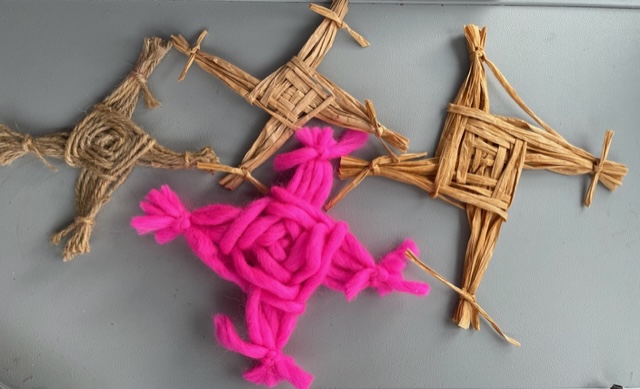
An assortment of St Brigid’s crosses
There is also a delightful tale about its creation.
An old pagan Chieftain lay delirious on his deathbed in Kildare (some believe this was Brigid’s father) and his servants summoned Brigid in the hope that the saintly woman could calm his restless spirit. Brigid is said to have sat by his bed, consoling and calming him . She picked up rushes from the floor and wove them into the distinctive cross pattern. Whilst she wove them, she explained the meaning of the cross to the sick Chieftain and it is thought her calming words brought peace to his soul. He was so enamoured by her words that the old Chieftain requested he be baptized as a Christian just before his passing. I can understand why this would have calmed him and made him receptive to the gospel. I find that creating St Brigid crosses is a very rhythmic, soothing and meditative practice.
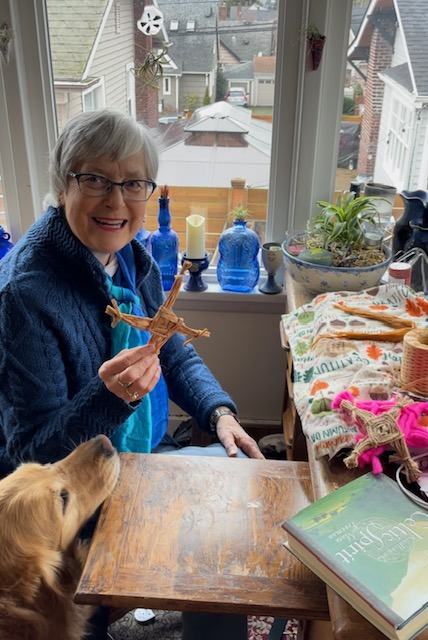
Making St Brigid’s cross with Goldie’s help
So lets give it a go.
This description is adapted from Kindling the Celtic Spirit by Mara Freeman. A fun way to do this is to sit around a bonfire or fire pit while you create. Maybe even combine it with a feast of Celtic yummies. I don’t have any of the traditional Bride’s Bannock which is made either in a heavy iron skillet or a barbecue grill, but I will pull out the last of my Scottish shortbread to enjoy while we work.
What you will need:
3 dozen strands of rushes, yarn, twine, or straw. about 15 inches each.
String for tying ends
I used Raffia Paper Craft Ribbon for this video.
Additional crosses in the picture are made from Jute twine and knitting yarn. The fun thing about these is that you can make multicolored crosses if you like. The disadvantage is that the crosses are not as stiff when finished in fact the bright yarn cross is quite floppy. However as you can imagine this would be a very fun activity for kids.
- Soak the weaving materials in hot water until they are flexible.The raffia and yarn only need to be dunked in water and then removed and wrung out. Wrap in a damp cloth to keep them flexible while weaving.
- Imagine the face of a clock measuring the year of time. Place one straw vertically pointing toward 12 o’clock (north, winter) Fold.a second straw in half around the center of the first pointing towards 3 o’clock (east, spring) Fold the next straw in half and place it over the second straw pointing towards 6 o’clock (south, summer). Fold the next straw over straw 1 and 3, pointing towards 9 o’clock (west, autumn) Continue to work in a circular pattern of folded straws, progressing outwards, carefully weaving the straws side by side. Tighten the straws and reposition to fill in the gaps where needed.
- As you create your cross, meditate on the events of your life, past, and present woven together. Visualize what you want to see happen in the coming year and consider that each straw weaves a dream for your future.
- When at least 28 straws have been woven from the centre of the cross, tie off each arm, with about 3″ allowed for the arms. Trim ends evenly.
- Once the cross is dry hang it inside by the door
- Finish by reciting Brigid’s Feast
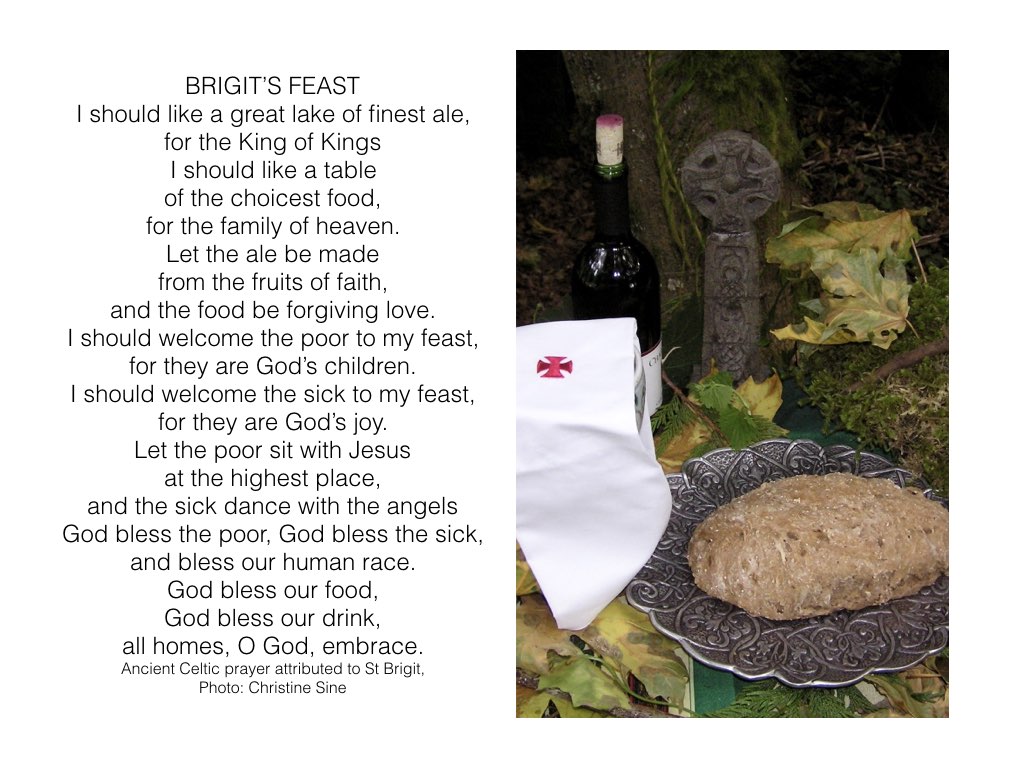
A contemplative service with music in the spirit of Taizé. Carrie Grace Littauer, prayer leader, with music by Kester Limner and Andy Myers.
Thank you for praying with us!
Permission to podcast/stream the music in this service obtained from One License with license #A-710-756.
“The Lord is My Light”, “Nada Te Durbe”, “God is Forgiveness”
Copyright and all rights reserved by GIA/Les Presses de Taizé
“Bring Your Peace”, “Litany of the Beatitudes”
Words and music by Kester Limner, shared under the Creative Commons License, Attribution (CC-BY)
How is your season of Epiphany going? It’s dark and grey here in Nashville and I really need to be reminded that we are in the Season of Light! My good friend Kara K. Root has a wonderful reflection on Epiphany that can inspire us all to keep following the Star and seeking the LIGHT. I love how she brings the story to life! I highly recommend lighting a candle, grabbing a cup of tea or coffee and reflecting on the story and the wonder of God. If you have chosen a STAR WORD or a word for the year, you might get that out and spend some time considering how Jesus is already using that word or words in your life. Thanks so much Kara for sharing your beautiful words with us! Lilly
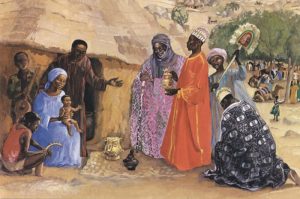
Mafa Visit of the Wisemen
When Epiphany dawns, the swaddling clothes have long been packed away in the attic of the peaceful little home, with room for a workshop that Joseph had rented them in Bethlehem, not too far from THE stable, actually, but near enough to town that he got a little business, enough to keep food on the table.
And to be honest, since the night when the shepherds and angels and everyone showed up in a wild blur of glory and honor, life has been kind of quiet. Mary and Joseph are far from the people and place they’d call home, no grandparents pitching in or aunties around offering advice through Jesus’ first fever, first tooth, first words, first steps. Leaning on their new community for connection and support. This was not how they imagined their family life would start- not even once they rearranged their imaginings to include God-incarnate crawling across the living room floor. Other than that one time Aunt Elizabeth and Uncle Zechariah came to visit, commiserating over sleepless nights and nursing woes while the babies gurgled together on a blanket on the floor, it has mostly been just the three of them, mama, dada and Jesus, getting to know each other, gently becoming a family. Week to week, season to season, it’s an ordinary life.
Until the pagans show up and call their kid the king of the Jews.
Just when the story begins to lose its hard edges, when the nostalgia starts to descend and the lens begins to soften, when this baby has begun to feel like he is theirs, a reminder that he is not arrives in the form of sages from a far-off land, astrologers, scientist mystic-scholars who had been watching the skies for signs of God.
Surprising, perhaps, that those with no personal stake in the story generational anticipation of a Messiah, or claim to Yahweh’s promises to the people claimed by Yahweh, are the ones Yahweh involves next. Their arrival bursts the domestic bubble and exposes the light to all the world.
Epiphany, we call this day. Enlightenment. Aha! When the scene is illuminated what was familiar and known one second look completely other and utterly amazing the next, often because you suddenly see things with a broader perspective, or through the eyes of another.
The Christmas moment speaks God WITH US, Epiphany says GOD with us.
Attention! Sweet and cuddly though he is, folks, this isn’t your own private Messiah. He belongs to the whole earth! And all who live upon it belong to this little one who has settled himself contentedly here in your lap. You are recipients of this miracle as much as the next person, of course, but with just as little sense of what it all means as the rest of us, maybe even less, actually, than these astonishing strangers who have arrived on your doorstep seem to grasp.
After this great entourage of exotic travelers that have flooded this quiet, provincial town exchange greetings with his parents and bestow their gifts on the child (and there were certainly many of them, of course; what a silly modern assumption that there were just three, because one gift a piece), after the camels have been tended to and bedded down, the tents erected and the strangers washed up and unpacked, I love the crazy, cozy image of lamps lit, table set, Mary and Joseph and their surprise visitors all crowded around an unexpected potluck of fragrant dishes. Wall to wall humans, who look different and smell different and wear different clothing and speak different languages, and whose paths never, ever should have crossed on this planet in any conceivable way, breaking bread together, drinking wine together, sharing together what used to be mostly their own private secret that nobody else could relate to. Perhaps tomorrow they’ll invite the shepherds back over for breakfast.
These travelers, who have journeyed over desert and mountains, through seasons and struggles, countless freezing nights and endless scortching day, driven by a quest through unknown to arrive at the very source. And then, from the moment they lay eyes on the child, and Mary and Joseph lay eyes on them, the cosmic cat is out of the bag, so to speak.
The ego-maniacal King Herod is now chomping at the bit to stamp out this newly discovered threat to his power, and the news is out, things are not business as usual; God has really come, the world is topsy-turvy and strangers from a strange land are visiting that nice couple down the street, normal as you please. And it’s as though that one lone star now shatters into a trillion pieces, filling the sky with bright mess, scattering shards of radiance from one end of the globe to the other.
Of course they stayed a while, these unexpected guests. After all, it took many months, maybe years, to get there, they’re not just spending one night and leaving. So what was it like, adjusting to being next to the miracle for a while? Was it all the more miraculous for its ordinariness?
How did it feel to go from a distant star and a lifelong, theoretical quest for truth to a flesh and blood child who threw bawling toddler tantrums when he needed a nap, smeared hummus on the dog, and belly-laughed when daddy tickled him with his beard?
Because here’s a truth, miracles are almost never as sexy in person as they’re built up to be.
What was it like for Mary and the strangers from the East to fall into some daily patterns together, to have almost nothing humanly in common and yet get one another at a cellular level, sharing in a reality nobody else on earth yet sees, representing to each other by their presence that this really is real. God has really come; the world is being redeemed. This wonky little collection of folk are now church, if church means, and I think it does, the people gathered around Jesus wondering together who God is, and watching together what ,God is up to. But also, maybe, getting annoyed because they load the dishwasher wrong and forget to take their shoes off in the house?
And then after the long visit, and the dreamt warning not to go back to Herod, and the Magi bypassing Jerusalem to return home by another road – (Oh, wasn’t Herod steaming mad when then never swung back by the palace! Didn’t he pace on his balcony with his eyes on the horizon day after day, the realization slowing dawning after one week, two, three, that they were NOT coming back, and there wasn’t a darn thing he could do about it!) – Just after the hugs and blessings and goodbyes, the little family turns back inside, sighing, and expecting, perhaps, that life might return to normal: normal is redefined again.
Epiphany keeps going, you see. It doesn’t actually let you turn back.
By its very nature Epiphany’s path is almost always that of another road.
The new road is revealed when, three years after the one who told him not to be afraid to take Mary as his wife, an angel messenger invades Joseph’s dreams, saying, Take the child and his mother and flea, right now, go to Egypt. Get up! NOW. And it’s your turn, Joseph, to be the strangers from a foreign land.
God-with-us, who was born in a stable is now transient and homeless, and you along with him, foreigners in a foreign land.
Some traditions hold that the little family settled in Egypt with the Ishmaelites, that they were received warmly by the way other side of the family tree, way back before Egypt became the land of captivity, the place from which Yahweh delivered the Israelites from slavery, back from the time when it was all the same trunk, the roots, the beginning. Father Abraham – father of us all, descendants as numerous as the stars.
It’s like baby God is on a sightseeing tour of the greatest hits.
I have been at this project for quite some time, you see…
So to the land of Egypt they went, (part of the Roman Empire at the time), seeking safety and welcome in the hospitality, hearts and homes of strangers, who are all part of the whole great story anyway, while back home among the children of Israel, the so-called “King of the Jews” Herod’s terrible wrath and fear ordered the deaths of all male children under two in an effort to stamp out the light of the world before the flame caught and spread.
Then it was fulfilled what had been spoken through the prophet Jeremiah: ‘A voice was heard in Ramah, wailing and loud lamentation, Rachel weeping for her children; she refused to be consoled, because they are no more.’
And I hate that part of the story and will never understand it, and don’t have a whole lot to say about it, except to notice both that God’s love doesn’t keep madness from happening but suffers it with us, coming as a homeless, transient peasant child, whose identity is revealed to nameless sheep-herders and pagan foreigners and NOT to the powers that be, no matter how loudly they rattle their sabers and fiercely they demand to be in on the secret, and also that as sweeping and awful as Herod’s act of terrible evil was, it seemed not to make a dent whatsoever in the God-with-us project. And while Herod himself is long dead and gone, love endures forever, profoundly and mightily, and every single day God-with-us is with us, transforming our shared life, bringing belonging and hope, redemptive kindness and healing care, and continuing to break through the darkness with light, every moment of every day.
After Herod’s death the little family finally journeys to Galilee, where they settle down at home amid grandparents and lifelong neighbors, to raise their first-grader in Nazareth, where he will run through the same streets, swim in the same streams, sit in the same school and participate in the same synagogue they did, in the tiny familiar world that had cradled and shaped them before their lives were ripped open by the light of the world.
How was little Jesus shaped by those early wanderings, I wonder?
What did he absorb from the Magi and the Egyptians, from the journeys and the dreams, and then from those who shaped his sense of home? How did Epiphany bend his path?
And what about those Magi? The journeyers, soul friends and miracle sharers who brought epiphany onto the scene as much as they received it themselves? What became of their lives after their encounter with the light of the world? How were they drawn into a lifetime of attunement to epiphany?
Epiphany keeps going, friends. The light of the world shimmers in our very own lives. And nobody gets to own this story – this story holds us all. It can’t be domesticated. What God is doing is always bigger, always more, always beyond us, and also right here next to us, in the minutia of our very ordinary lives. It pierces the darkness, the horrors, the loneliness, the wandering. It shares the awkward and unknown, the familiar and the comforting, the strange and the new, the death and the life, drawing us out into worlds we can’t imagine, bringing us home by roads we can’t foresee.
Today we get star words. They are not magic. But they are a chance to lift our heads and look beyond ourselves with hearts open to however Christ might encounter us, attentive to wherever God might lead us this year. God is with us, transforming the world.
So, arise, shine, beloved, your light has come.
Happy Epiphany.
Kara K Root a writer, spiritual director, workshop leader, and the Pastor of Lake
Nokomis Presbyterian Church in Minneapolis, MN, a Christian community that shapes
its life around worship, hospitality and Sabbath rest. Kara’s new book, The Deepest
Belonging: A Story of Discovering How God Meets Us. Copyright 2021, Fortress
Press. Kara Blogs at In the HereandNow
MAIN PHOTOGRAPH...Flight into Egypt by Henry Ossawa Tanner 1907 oil on canvas. Painting found at the Cincinnati Art Museum
Last week we highlighted a list of books on discernment, so to continue the theme, this week we have a list focused on listening. How do we listen and what do we listen to? Back in 2016 we began to compile a list of books on listening based on suggestions from our Godspace contributors, and have revisited the list several times to update and expand it. The follow is a list our suggestions – from many different perspectives and understandings. If you have any suggestions of your own, please put them in the comments. Enjoy and make sure you listen well!
- Anderson, Keith: A Spirituality of Listening: Living What We Hear
- Baab, Lynne: The Power of Listening: Building Skills for Mission and Ministry
- Bill, J. Brent: Holy Silence: The Gift of Quaker Spirituality
- Brenner, Juliet: Contemplative Vision: A Guide to Christian Art and Prayer
- Buechner, Frederick: Listening to Your Life
- de Caussade, Jean-Pierre: The Sacrament of the Present Moment
- Deere, Jack: Surprised by the Voice of God
- Goll, James W.: The Lost Art of Practicing His Presence
- Guenther, Margaret: Holy Listening: The Art of Spiritual Direction
- Fr. Gabriel: Divine Intimacy
- Richard Foster: Prayer: Finding the Heart’s True Home and Sanctuary of the Soul: Journey into Meditative Prayer
- Hart, Thomas: The Art of Christian Listening
- Hipps, Shane: Flickering Pixels
- Huggett, Joyce: The Joy of Listening to God
- Iyer, Pico: Art of Stillness: Adventures in Going Nowhere
- Kelly, Thomas: A Testament of Devotion
- Kidd, Sue Monk: When the Heart Waits: Spiritual Direction for Life’s Sacred Questions
- Long, Anne: Listening
- Loring, Patricia: Listening Spirituality Vol. I and Vol. II
- Merton, Thomas: Thoughts in Solitude and Contemplative Prayer and Dialogues with Silence.
- Miller, James E.: The Art of Listening in a Healing Way and The Art of Being a Healing Presence
- Nepo, Mark: Seven Thousand Ways to Listen: Staying Close to What Is Sacred
- Newell, J. Phillip: Listening for the Heartbeat of God: A Celtic Spirituality
- Nouwen, Henri: The Way of the Heart: Connecting with God Through Wisdom, Prayer and Silence and Discernment: Reading the Signs of Daily Life
- Palmer, Parker: Let Your Life Speak and A Hidden Wholeness
- Peel, Donald: The Ministry of Listening
- Phillips, Susan: Candlelight: Illuminating The Art of Spiritual Direction and The Cultivated Life
- Rohr, Richard: Everything Belongs: The Gift of Contemplative Prayer
- Valters Paintner, Christine: Lectio Divina: the Sacred Art and Illuminating the Way; Embracing the Wisdom of Monks and Mystics
- Virkler, Mark: How to Hear God’s Voice
- Wilson, Rob: How Do I Help a Hurting Friend
For more books on The Art of Discernment, check out this resource list.
NOTE: As an Amazon Affiliate I receive a small amount for purchases made through appropriate links. Thank you for supporting Godspace in this way.
The lights of the Christmas season have been extinguished. The Feast Day celebration of the Epiphany has concluded. As for following the “star of wonder,” it too has continued on its journey, passing me by. As I let go of this sacred story for another year, I felt like both my neighborhood and the world was descending into more darkness.
Letting go of the Christmas season has been hard for me this year. As I have been recovering from foot surgery, I am still confined to the house, unable to walk outdoors or to drive to visit my grandsons. The decorations and lights of Christmas provided me with “tidings of comfort and joy” and honestly, distraction from what is reality. Hard as it was, this past weekend I decided it was time to put away Christmas. I hoped that the ritual of boxing it all up would somehow move me along emotionally. And yet I fell into more sadness as I was reminded of a few lines from W. H. Auden’s poem, For the Time Being: A Christmas Oratorial.
Well, so that is that. Now we must dismantle the tree,
Putting the decorations back into their cardboard boxes. Some have got broken…
But, for the time being, here we all are. In the meantime. There are bills to be paid, machines to keep in repair, irregular verbs to learn; the Time Being to redeem from insignificance. The happy morning is over.
The happy morning is over. After boxing up Christmas and Epiphany, yes, I felt like that. But rather than deny it, I sat with that phrase for some time. The next morning, unable to sleep, I arose at 5:00 a.m. and waited and watched for the dayspring, the first light of dawn to appear. It did and in fact, it was a happy morning! I remembered, I saw, I felt that there is always the Good News!
In the season of Epiphany, the “Time Being” has been redeemed from insignificance! The Christian Church proclaims that the manifestation of God in Jesus came, has come, and will come again. A new light is present in the world. There is another star for us to follow. The happy morning is just beginning.
Epiphany is the season of more daylight. I look forward to these longer days and shorter nights. But in the midst of winter, I do not follow the star of Bethlehem. Instead, I look each day for the daystar to appear. How faithful our sun is in making its journey north again!
I am not a sun worshipper but I am a sun appreciator. It serves as a wonderful metaphor for the light of Christ coming into the world, every day, in every human heart. Yes, the light might be burning low or buried deep within the angry, grieving and wounded hearts of some, but the divine spark is there waiting in all hearts to be uncovered and revealed.
The gift of Christmas is to receive the light of Christ. The gift of Epiphany is to manifest or reveal that light, Christ’s light, to others. Today I found myself returning to a favorite hymn text written by Charles Wesley. It has become a part of my morning meditation.
Christ, whose glory fills the skies,
Christ the true, the only Light,
Sun of Righteousness, arise,
Triumph o’er the shades of night;
Dayspring from on high, be near;
Daystar, in my heart appear.
Dark and cheerless is the morn
Unaccompanied by Thee;
Joyless is the day’s return
Till Thy mercy’s beams I see;
Till they inward light impart,
Glad my eyes and warm my heart.
Visit, then, this soul of mine;
Pierce the gloom of sin and grief;
Fill me, Radiancy Divine;
Scatter all my unbelief;
More and more Thyself display,
Shining to the perfect day.
Charles Wesley, 1740
This text is an invitation for us to look for the moments of joy and gladness in each day. On cloudy days, when the sun is hidden, I know it is there. As with the sun, so it is with the Spirit of Christ. Trust, as I have discovered, is simply knowing that even though I do not see the sun nor Christ, they are both present. My sacred duty this year is to see Christ manifest in myself, in other human beings, in creation; and to manifest Christ to the world.
It sounds simple but for me it is not always easy. On some days I have to dive more deeply into my heart, my soul space to experience “radiancy divine.” My daily mantra or breath prayer is “Presence, I am present.”
Does praying it make it so? Not from a divine point of view, but from my human point of view, yes indeed. Becoming aware of God’s often unseen presence is as the Buddhist, Thich Nhat Hahn, has said “not a matter of faith but a matter of practice.”
By practicing, I mean praying– in the light and in the dark, in times of joy and in time of grief, in times of faith and in time of fear, in times of love and in time of anger. That IS how we to stay connected to Christ. I am grateful that I heard the call to return to praying Charles Wesley’s hymn text for the rest of the season. Christ’s glory does indeed fill the skies and “warm our hearts” when we are open.
This season I am also focusing on one line that Marianne Williamson wrote in her poem called, “A Return to Joy.” It is, “We were born to make manifest the glory of God that is within us.” I pray that Christ’s glory will be revealed to you this holy season and that “warming your hearts” you too will manifest Christ’s Good News to others. May it be so. Amen.
~ Goodfellow
Explore the wonderful ways that God and God’s story are revealed through the rhythms of planting, growing, and harvesting. Spiritual insights, practical advice for organic backyard gardeners, and time for reflection will enrich and deepen faith–sign up for 180 days of access to work at your own pace and get ready for your gardening season.
by Sue Duby
I cherish calm mornings. Those precious ones. Where the first waking moments welcome a mind clear of “clutter”. No particular agitating thoughts. No anxious musing over a “to do” list. No panicked moments over key details forgotten. No burdensome worries. Just the fresh breath of a new day, inviting a heart of gratefulness and anticipation. On those days, that mystery called “peace” comes so easily. Without effort on my part, it’s just there to enjoy. Enough to even boast a bit with that childhood chorus, ”I’ve got peace like a river in my soul”!
If only every morning dawn broke forth that way! More often, the initial calm leads to a quick tumbling of thoughts and pondering. Worries about friends and family. Puzzling situations that I can’t solve. Key decisions waiting for final answers. Irritations flavoring precious relationships. On those days, that “river in my soul” is churning and racing over boulders!
During a recent few moments glancing at Psalm 34, my eyes widened.
“Come, my children, listen to me;
I will teach you the fear of the Lord.Whoever of you loves life
and desires to see many good days,
keep your tongue from evil
and your lips from telling lies.” Psalm 34:11-13 NIV
At first, I quickly passed over familiar words and whispered to myself, “working on those things, Lord!”. The “listening”, watching my words and taking care to avoid exaggeration in my story telling.
Then, followed the fresh attention-getter:
“Turn from evil and do good;
seek peace and pursue it.” Psalm 34:14, (I Peter 3:11) NIV
I’ve spent years memorizing verses on peace (especially when I need it!). The ones that remind me of Him being the ruler, captain and author of peace. The One who gifts peace to us. The One who reminds us to receive His peace.
“For unto us a child is born, unto us a son is given:
and the government shlall be on his shoulder:
And he his name shall be called Wonderful Counselor, The mighty God, The everlasting Father, the Prince of Peace.” Isaiah 9:6 KJV
“Peace I leave with you; my peace I give you. I do not give to you as the world gives. Do not let your hearts be troubled and do not be afraid.” John 14:27 NIV
Somehow, in the journey, I missed those simple 5 words in Psalm 34:14. “Seek peace and pursue it.” They are much more than just receiving the gift He offers. Rather, instruction for steps to be taken. An invitation and request for specific obedience. My part of the bigger picture.
“Seek” means to search out, strive after or desire. An action and matter of the heart. Not simply waiting for Him to blanket my life’s moments with peace, but looking for places and ways to have my words, deeds and presence bring forth His peace. Always, by His enabling grace in my life.
“Pursue” means to chase or run after. Words painting a picture of a measure of intensity. Requiring much more than occasional effort. Purposing, with committed energy and a goal in mind. . . peace. Not only for my personal benefit, but in my journey with others.
This kind of peace is so much more than calm agreement or lack of tension. It actually means “completeness, soundness, welfare”. His heart for all of us. It’s a remarkable privilege that we can join Him in “chasing after” such peace, especially on behalf of others.
One commentary takes the challenge even further:
“Since nothing is more contrary to that love which never fails (which is the summary both of law and gospel, both of grace and glory) than strife and contention, which bring confusion and every evil work, we must “seek peace and pursue it”. We must show a peaceable disposition, study the things that make for peace, do nothing to break the peace and to make mischief. If peace seems to flee from us, we must pursue it; follow peace with all men, spare no pains, no expense, to preserve and recover peace; be willing to deny ourselves a great deal, both in honour and interest, for peace’ sake.” Matthew Henry
How often in conversations am I focused on making sure my opinion is properly understood? Desiring to “win” if tension rises in the discussion. Focused on my thoughts, rather than truly seeking to understand the words of another. Allowing irritations to build, leading to a closed heart in relationships. Not setting His kind of peace as the goal. Not being quick to seek the “completeness, soundness and welfare” of another, by laying down my perceived “rights”.
“My way” requires so much energy! Instead, if I fully trust that His way is best (even if it’s hard!), I can choose to “run after” His kind of peace. And in doing so, rest in watching His plans unfold.
While gratefully embracing the amazing gift of peace He so graciously give to us, may we be “peace seekers” in all our ways. Ones who purpose to join Him in bringing peace to our homes, relationships, work places and life moments. By His enabling grace, wisdom and strength.
“If it is possible, as far as it depends on you,
live at peace with everyone.”Romans 12:18 NIV
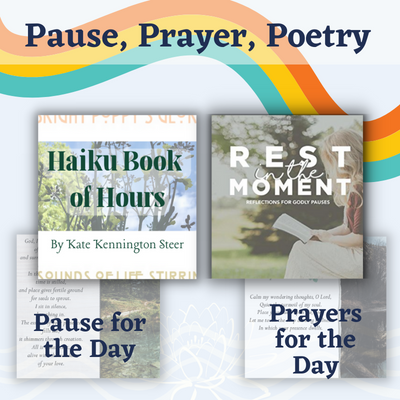 Whether you are praying the stations of the day, in need of resources for rest, hoping to spark joy and find wonder, or simply want to enjoy beautiful prayers, poetry, and art – our digital downloads section has many options! Christine Sine’s book Rest in the Moment is designed to help you find those pauses throughout the day. Praying through the hours or watches, you may find inspiration in our prayer cards set Prayers for the Day or Pause for the Day. You may find your curiosity piqued in the free poetry and art download Haiku Book of Hours. All this and more can be found in our shop!
Whether you are praying the stations of the day, in need of resources for rest, hoping to spark joy and find wonder, or simply want to enjoy beautiful prayers, poetry, and art – our digital downloads section has many options! Christine Sine’s book Rest in the Moment is designed to help you find those pauses throughout the day. Praying through the hours or watches, you may find inspiration in our prayer cards set Prayers for the Day or Pause for the Day. You may find your curiosity piqued in the free poetry and art download Haiku Book of Hours. All this and more can be found in our shop!
As an Amazon Associate, I receive a small amount for purchases made through appropriate links.
Thank you for supporting Godspace in this way.
When referencing or quoting Godspace Light, please be sure to include the Author (Christine Sine unless otherwise noted), the Title of the article or resource, the Source link where appropriate, and ©Godspacelight.com. Thank you!

